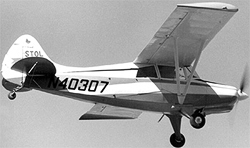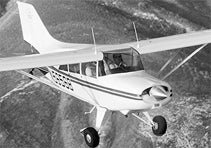 Maule M-5 |  Maule M-7 |
| STANDARD DATA:(M-4 Jetasen) Seats 4. Gross wt. 2,100. Empty wt. 1,100. Fuel capacity 42. Engine 145-hp Continental. PERFORMANCE: Top mph 157. Cruise mph Stall mph 40. Initial climb rate 700. Ceiling 12,000. Range 750. Takeoff distance 585. Landing distance (50') 600. STANDARD DATA: (M-4 Rocket) Seats 4. Gross wt. 2,100. Empty wt. 1,190. Fuel capacity 42. Engine 210-hp Continental. STANDARD DATA: (M-5-210C) Seats 4. Gross wt. 2,300. Empty wt. 1,350. Fuel capacity 42. Engine 210-hp Continental. STANDARD DATA: (M-5-235C) Seat 4. Gross wt. 2,300. Empty wt. 1,400. Fuel capacity 40-63. Engine 235-hp Lycoming. STANDARD DATA: (M-7-235) Seat 4-5. Gross wt. 2,500. Empty wt. 1,500. Fuel capacity 40-70. Engine 235-hp Lycoming O-540-J3A5. STANDARD DATA: (M-7-420AC) Seat 5. Gross wt. 2,500. Empty wt. 1,570. Fuel capacity 85. Engine 420-shp Allison 250-B17-C turbine. |
Belford D. (B.D.) Maule began a family airplane manufacturing business that received its first FAA type certificate in 1961. The first production model, known as the Jetasen M-4 was delivered in April 1962. Then, as now, all Maules are constructed in Moutrie, Georgia. The welded steel-tube fuselage is covered with fiberglass, and the shortspan wing is all-metal with a thick, high-lift airfoil. The airplane accomplishes its short-field performance with two-position flaps of an unusually high-lift capability and without the elaborate spoilers, slots, and other items normally associated with STOL design.
The original M-4 was powered by a 145-hp Continental engine, and in 1965, the Rocket entered production with a 210-hp Continental powerplant and a constant-speed propeller. The Astro-Rocket was a deluxe version of the Jetasen, housing a 180-hp Franklin. In 1967, the Strata-Rocket was introduced into the line. Basically similar to the Rocket, it was powered by a 220-hp Franklin. All aircraft mentioned thus far shared the same M-4 designation.
The first M-5 Lunar-Rockets were delivered in 1974 as M-5-21OCs with 210-hp Continental engines. As expected, the M-5-220C houses a 220-hp Franklin. These models differ from the earlier M-4s by having four cabin doors for hauling cargo as the "C" in the model number implies; otherwise, the M-5 has a 30% increase in flap area and enlarged tail surfaces to enhance its short-field performance. The 220-hp version was discontinued when the Franklin engine was no longer available, and the M-5-235C was added to the line in 1976 employing a 235-hp Lycoming.
In 1981, Maule installed an IO-540-W1A5D out front and began delivering the M-6, also available with EDO floats. Two years later the model would morph into the M-7 and in 1989, the M-8. In 1991, the company experimented with a turbine Maule, installing an Allison 420 shp 250-B17-C and eventually offered the design in both taildragger and tricycle gear configurations. The family continues to create endless variations and improvements on the original airframe, with the original fuselage jig designed by founder B.D. Maule still in use.

Subscribe to Our Newsletter
Get the latest Plane & Pilot Magazine stories delivered directly to your inbox





